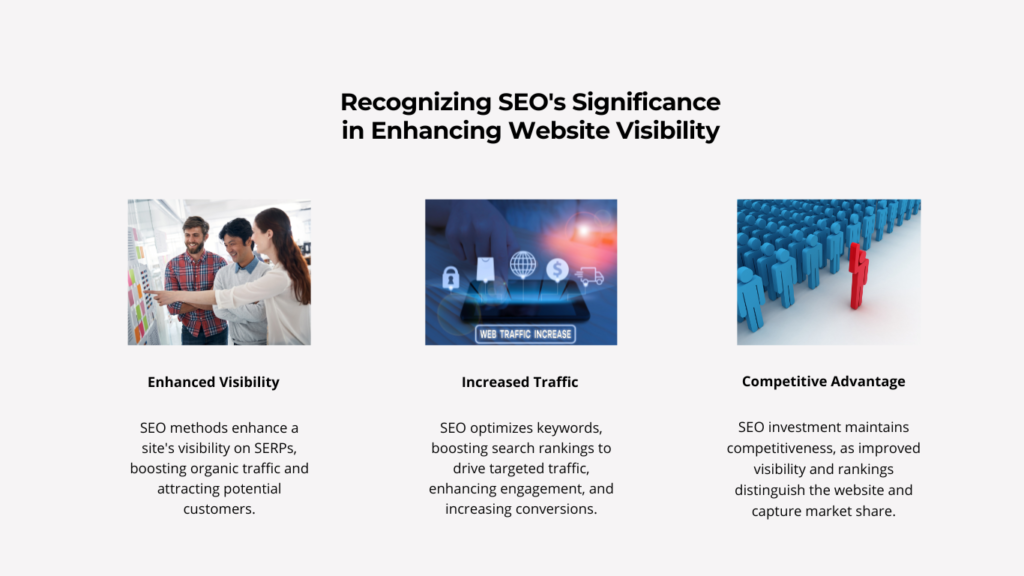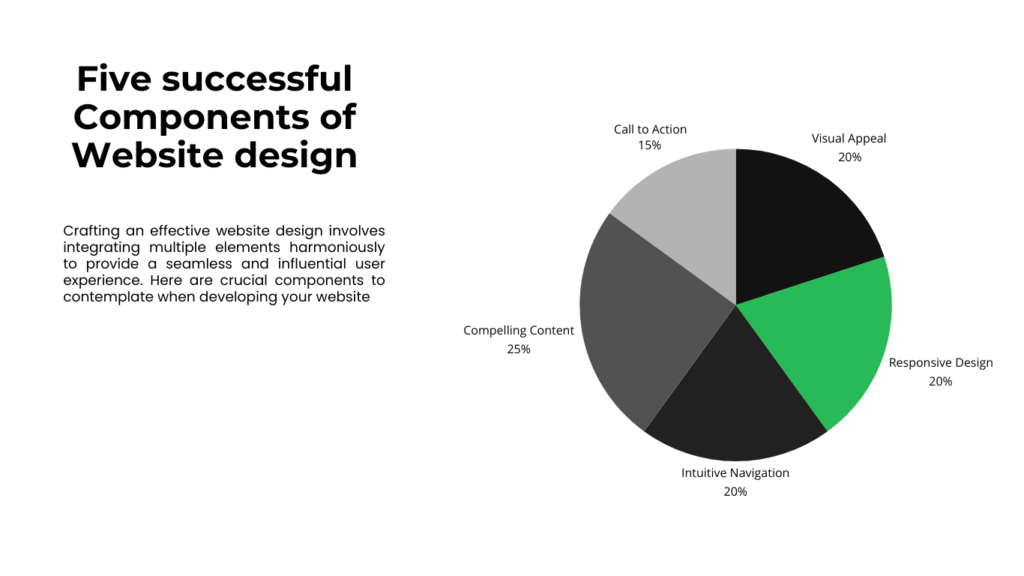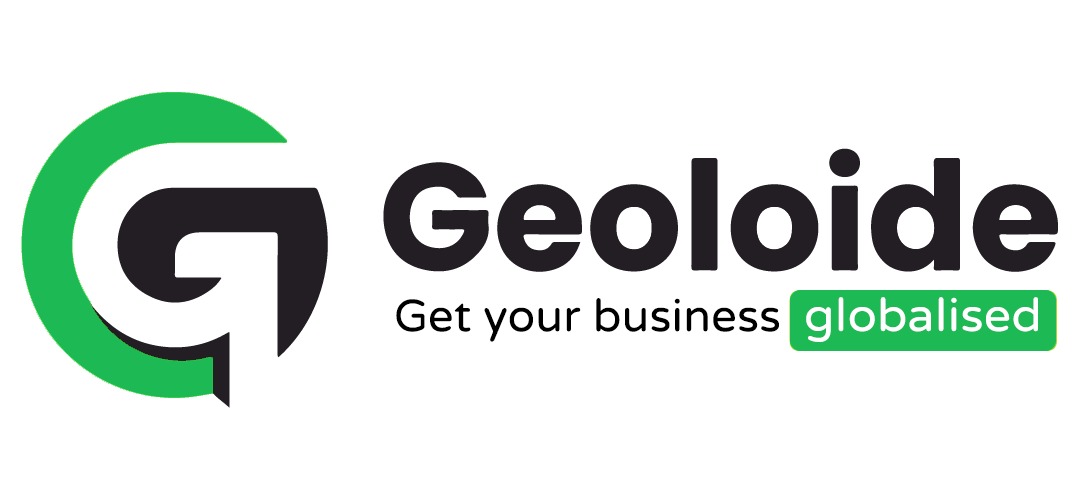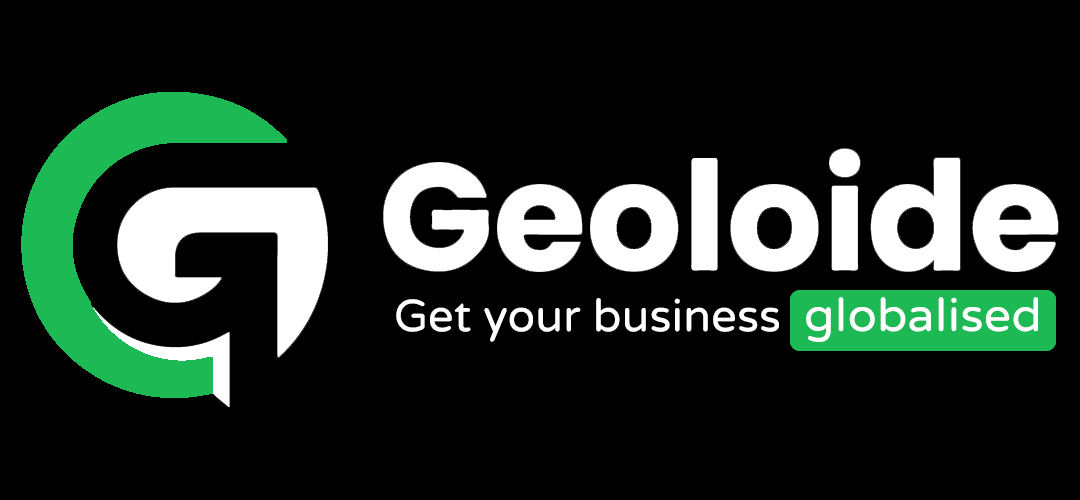Introduction
Are you tired of your website getting lost in the vast online landscape? Do you want to improve your website’s visibility and attract more organic traffic? Look no further because in this step-by-step guide, we will teach you how to crack the code of search engine optimization (SEO) and skyrocket your website’s visibility.
With the ever-increasing competition in the digital world, it’s essential to have a solid SEO strategy to rank high on search engine results pages. In this article, we will walk you through the ins and outs of SEO, from keyword research and on-page optimization to backlink building and monitoring your site’s performance.
Learn how to find the right keywords that will drive targeted traffic to your site and optimize your content to rank higher on search engines. Discover the power of backlinks and how to build a strong network of authoritative sites that vouch for your website’s credibility.

Don’t let your website remain hidden in the depths of search engine results. Follow our step-by-step guide, and watch your website soar to new heights of visibility and success.
Understanding the Importance of SEO for Website Visibility

In today’s digital age, having a website is not enough. With billions of websites on the internet, it’s crucial to make your website stand out from the crowd. That’s where SEO comes into play. Search engine optimization is the process of improving your website’s visibility on search engine results pages (SERPs) to attract more organic traffic.
Search engines like Google use complex algorithms to determine the relevance and quality of websites. By optimizing your website for search engines, you can increase your chances of ranking higher on SERPs, driving targeted traffic to your site, and ultimately boosting your online visibility.
How Search Engines Work
To crack the code of SEO, it’s important to understand how search engines work. Search engines have two primary functions: crawling and indexing websites, and providing users with relevant search results.
Crawling is the process of discovering web pages by following links from one page to another. Search engine bots, also known as spiders or crawlers, visit websites and collect information about their content, structure, and links. This information is then indexed, which means it is added to a searchable database.
When a user performs a search query, the search engine retrieves the most relevant results from its index and presents them in the search results. The relevance of a web page is determined by various factors, including keyword usage, page authority, and user experience.
Understanding how search engines work is crucial because it helps you optimize your website to align with their algorithms and increase your chances of ranking higher on SERPs.
The Basics of On-Page Optimization
On-page optimization refers to the process of optimizing individual web pages to improve their visibility on search engines. It involves optimizing various elements on your website, including content, meta tags, URLs, and internal linking structure.
One of the most important aspects of on-page optimization is keyword usage. Keywords are the words or phrases that users enter into search engines when looking for information. By conducting thorough keyword research, you can identify the most relevant and high-value keywords for your website.
Once you have identified your target keywords, it’s important to incorporate them strategically into your content. This includes optimizing your page titles, headings, meta descriptions, and URL structure. However, it’s essential to maintain a natural and user-friendly approach to avoid keyword stuffing, which can negatively impact your website’s visibility.
In addition to keyword optimization, on-page optimization also involves improving the overall user experience of your website. This includes optimizing your website’s loading speed, mobile responsiveness, and navigation structure. By providing a seamless and user-friendly experience, you can increase the chances of users staying on your site, engaging with your content, and ultimately boosting your website’s visibility.
Conducting Keyword Research for SEO
Keyword research is a critical step in any successful SEO strategy. By identifying the right keywords, you can attract targeted traffic to your website and increase your chances of ranking higher on search engine results pages.
Start your keyword research by brainstorming a list of relevant topics and terms related to your website or business. Put yourself in the shoes of your target audience and think about what they would search for when looking for information in your niche.
Once you have a list of potential keywords, it’s important to evaluate their search volume and competition. There are various keyword research tools available, such as Google Keyword Planner, SEMrush, and Ahrefs, that can help you analyze keyword metrics like search volume, competition level, and keyword difficulty.
Look for keywords with a decent search volume and low to moderate competition. These keywords are more likely to drive targeted traffic to your website and have a higher chance of ranking on SERPs.
After identifying your target keywords, it’s important to incorporate them strategically into your website’s content, meta tags, and URLs. However, remember to focus on providing high-quality and engaging content that meets the needs of your audience. Keywords should be used naturally and not at the expense of user experience.
Creating High-Quality and Engaging Content
When it comes to SEO, content is king. High-quality and engaging content not only attracts users but also signals to search engines that your website is valuable and relevant.
When creating content for your website, it’s important to focus on providing value to your audience. Address their pain points, answer their questions, and offer unique insights. By providing valuable content, you can establish yourself as an authority in your niche and attract organic traffic to your website.
In addition to value, it’s important to optimize your content for search engines. This involves incorporating your target keywords naturally into your content, headings, and meta tags. However, avoid keyword stuffing and prioritize the readability and flow of your content.
Furthermore, consider using multimedia elements like images, videos, and infographics to enhance the visual appeal of your content. These elements not only make your content more engaging but also increase the chances of it being shared and linked to by other websites, which can improve your website’s visibility and SEO.
Optimizing Website Structure and Navigation
A well-structured and user-friendly website is crucial for both user experience and SEO. A clear and intuitive website structure allows users to navigate your site easily and find the information they’re looking for, while also helping search engines understand the organization of your content.
Start by organizing your website into logical categories and subcategories. This hierarchical structure makes it easier for users and search engines to navigate your site. Use descriptive and keyword-rich URLs for your pages to provide additional context and improve SEO.
In addition to a clear structure, internal linking is also important for website optimization. Internal links connect different pages within your website and help search engines discover and index your content. They also help distribute link equity throughout your site, improving the authority and visibility of individual pages.
When creating internal links, use descriptive anchor text that includes relevant keywords. This not only improves the user experience but also signals to search engines the relevance and context of the linked page.
Building Backlinks for SEO
Backlinks are one of the most important factors in search engine ranking algorithms. A backlink is a link from another website to your website. Search engines consider backlinks as votes of confidence and authority for your website.
Building a strong network of high-quality backlinks can significantly improve your website’s visibility and SEO. However, it’s important to focus on quality rather than quantity. One authoritative backlink from a reputable website is more valuable than multiple low-quality backlinks.
Start by identifying authoritative websites in your niche and reach out to them for potential guest posting opportunities or collaborations. Guest posting involves writing and publishing articles on other websites with a link back to your site. This not only helps you build backlinks but also exposes your content to a wider audience.
Another effective way to build backlinks is through content promotion and outreach. Create valuable and shareable content that naturally attracts links from other websites. Reach out to influencers, bloggers, and journalists in your industry and ask them to consider linking to your content.
Remember that building backlinks takes time and effort. It’s important to focus on building genuine relationships and providing value to other websites. Avoid using black hat techniques like buying links or participating in link schemes, as these can result in penalties from search engines and harm your website’s visibility.
Measuring and Tracking SEO Success
Once you have implemented your SEO strategy, it’s important to measure and track its success. Monitoring your website’s performance allows you to identify what’s working and what needs improvement, enabling you to make data-driven decisions for better SEO results.
Start by setting up Google Analytics and Google Search Console for your website. These free tools provide valuable insights into your website’s traffic, user behavior, and search performance. Monitor key metrics like organic traffic, bounce rate, average time on page, and conversion rates.
Regularly review your website’s rankings on search engine results pages for your target keywords. Keep an eye on your competitors and analyze their SEO strategies. Look for opportunities to improve your content, backlink profile, and overall website optimization.
Additionally, use SEO auditing tools like SEMrush, Moz, or Screaming Frog to identify technical issues, broken links, and other SEO-related problems. Addressing these issues promptly can improve your website’s visibility and user experience.
Remember that SEO is an ongoing process. It’s important to regularly review and update your SEO strategy based on the latest industry trends and search engine algorithm updates. By continuously monitoring and optimizing your website, you can maintain and improve its visibility over time.
SEO Tools and Resources for Website Optimization
The world of SEO is constantly evolving, and there are numerous tools and resources available to help you optimize your website and stay on top of the latest trends. Here are some essential SEO tools and resources to consider:
- Google Analytics: A free tool that provides valuable insights into your website’s traffic, user behavior, and conversions.
- Google Search Console: Another free tool from Google that helps you monitor and maintain your website’s presence in search results.
- SEMrush: A comprehensive SEO tool that provides keyword research, competitor analysis, and performance tracking features.
- Moz: Offers a suite of SEO tools, including keyword research, link analysis, and rank tracking.
- Ahrefs: A popular tool for backlink analysis, keyword research, and competitor analysis.
- Yoast SEO: A WordPress plugin that helps optimize your website’s on-page SEO elements.
- Backlinko: A website and blog by Brian Dean that offers in-depth SEO guides, case studies, and strategies.
- Search Engine Journal: An online publication that covers the latest news, trends, and strategies in SEO and digital marketing.
By leveraging these tools and resources, you can streamline your SEO efforts and stay ahead of the competition.
Conclusion: Taking Your Website’s Visibility to New Heights with SEO
In the vast online landscape, having a website is not enough. To stand out and attract organic traffic, you need to crack the code of SEO. By understanding search engines’ algorithms, conducting keyword research, optimizing your content and website structure, building high-quality backlinks, and monitoring your website’s performance, you can skyrocket your website’s visibility and achieve success in the digital world.
Remember that SEO is a continuous process that requires time, effort, and ongoing optimization. Stay up to date with the latest trends and algorithm updates, and always prioritize providing value to your audience. With the right SEO strategy and implementation, your website can soar to new heights of visibility and success.
- March 23, 2024
Introduction
As the digital landscape continues to evolve, having a strong online presence has become crucial for businesses of all sizes. And at the heart of a compelling online presence is an effective website design. Website design goes beyond aesthetics; it encompasses the user experience, functionality, and overall impression your website makes on visitors. In fact, studies have shown that 75% of users judge a company’s credibility based on their website design.
When visitors land on your website, they form an opinion within seconds. A well-designed website can captivate their attention, engage them, and encourage them to explore further. On the other hand, a poorly designed website can lead to high bounce rates and lost opportunities. With fierce competition in the online space, it is essential to invest in professional website design to ensure your business stands out from the crowd.

Understanding User Experience and Its Role in Website Design
User experience (UX) is a critical aspect of website design that focuses on enhancing the overall satisfaction of users when they interact with a website. It encompasses factors such as ease of navigation, intuitive design, fast load times, and clear calls to action. A positive user experience encourages visitors to stay longer, browse more pages, and ultimately take desired actions, such as making a purchase or submitting a contact form.
To create a seamless user experience, it is important to understand your target audience and their preferences. Conduct user research and gather feedback to gain insights into their needs, expectations, and pain points. By aligning your website design with the user’s journey and addressing their specific pain points, you can create a more personalized and engaging experience that keeps them coming back for more.
5 Key Elements of Effective Website Design
Effective website design is a combination of various elements working together to deliver a cohesive and impactful user experience. Here are some key elements to consider when designing your website:

1. Visual Appeal: The visual design of your website should reflect your brand identity and create a positive first impression. Use high-quality images, cohesive color schemes, and visually appealing typography to engage visitors.
2. Responsive Design: With the increasing use of mobile devices, it is crucial to ensure your website is responsive and adapts seamlessly to different screen sizes. A responsive design enhances user experience and improves your website’s visibility in search engine rankings.
3. Intuitive Navigation: Make it easy for users to find what they are looking for by implementing clear and intuitive navigation menus. Avoid clutter and confusion by organizing your content into logical categories and providing search functionality.
4. Compelling Content: Engaging and informative content is key to capturing and retaining user attention. Use persuasive copywriting techniques and incorporate relevant keywords to improve your website’s search engine optimization (SEO) and attract organic traffic.
5. Call to Action: A well-designed website should guide users towards taking desired actions. Utilize strategically placed call-to-action buttons and forms to encourage conversions, such as signing up for a newsletter or making a purchase.
How Geoloide’s Expert Services Can Elevate Your Online Presence
Geoloide is a trusted provider of professional website design and development services. With their expertise and industry knowledge, they can help elevate your online presence and drive meaningful results. Whether you are looking to create a brand-new website or revamp your existing one, Geoloide’s team of skilled designers and developers can tailor a solution to meet your specific needs.
By partnering with Geoloide, you gain access to their deep understanding of user experience and their ability to translate that knowledge into a visually stunning and functional website. They will work closely with you to understand your business goals, target audience, and unique selling propositions, ensuring that your website not only looks great but also drives conversions.
Geoloide’s commitment to excellence is reflected in their portfolio of successful website design projects. They have helped businesses across various industries achieve remarkable online presence, resulting in increased brand visibility, higher engagement, and improved conversion rates. With their expertise in responsive design, search engine optimization, and user-friendly interfaces, Geoloide can help your business stay ahead in the digital age.
Examples of Successful Website Design and Their Impact on Businesses
To illustrate the power of effective website design, let’s take a look at a few examples of businesses that have leveraged it to achieve remarkable results:
1. Apple: Apple’s website is a prime example of sleek and minimalist design. The use of high-resolution product images, concise copy, and intuitive navigation creates a visually appealing and user-friendly experience. This design approach has contributed to Apple’s brand image of elegance, simplicity, and innovation.
2. Airbnb: Airbnb’s website design focuses on showcasing stunning visuals of properties and travel experiences. The use of user-generated content and social proof builds trust and encourages users to book their next vacation through the platform. The website’s intuitive search functionality and personalized recommendations further enhance the user experience.
3. Nike: Nike’s website design embodies the brand’s energy and athleticism. The use of vibrant colors, dynamic visuals, and bold typography creates an engaging and exciting experience for visitors. Nike’s website also seamlessly integrates e-commerce functionality, allowing users to browse and purchase products effortlessly.
These examples demonstrate how a well-designed website can align with a brand’s identity, engage users, and drive desired actions. Investing in professional website design services, like those offered by Geoloide, can help your business achieve similar success.
The Benefits of Investing in Professional Website Design Services
Investing in professional website design services can yield numerous benefits for your business:

1. Enhanced Brand Perception: A professionally designed website enhances your brand’s credibility and creates a positive perception among visitors. It reflects the professionalism and attention to detail that you bring to your products or services.
2. Improved User Experience: Professional website design focuses on optimizing the user experience, resulting in increased engagement, longer visit durations, and higher conversion rates. By providing users with a seamless and intuitive experience, you can build trust and loyalty.
3. Competitive Advantage: In a crowded online marketplace, a well-designed website can give you a competitive edge. It sets you apart from competitors and positions your business as a leader in your industry.
4. Search Engine Optimization (SEO) Benefits: Professional website design incorporates SEO best practices, ensuring your website is optimized for search engines. This can lead to improved search rankings, increased organic traffic, and greater visibility for your business.
5. Adaptability and Scalability: Professional website design allows for scalability and adaptability as your business grows. It provides a solid foundation that can accommodate future updates, changes, and expansions.
By investing in professional website design services, you are making a long-term investment in the success of your business.
Common Website Design Mistakes to Avoid
While understanding the key elements of effective website design is important, it is equally crucial to be aware of common mistakes to avoid. Here are a few pitfalls to steer clear of:
1. Cluttered Layout: A cluttered layout overwhelms visitors and makes it difficult for them to find what they are looking for. Keep your design clean and organized, with ample white space to create a visually pleasing and user-friendly experience.
2. Slow Load Times: Slow loading websites frustrate users and can lead to high bounce rates. Optimize your website’s performance by minimizing file sizes, leveraging caching techniques, and choosing a reliable hosting provider.
3. Lack of Mobile Optimization: With the majority of internet users accessing websites on mobile devices, it is crucial to ensure your website is fully optimized for mobile. A poor mobile experience can drive away potential customers and harm your search engine rankings.
4. Poor Typography: Typography plays a significant role in website design, affecting readability and overall visual appeal. Avoid using illegible fonts, overly small text sizes, and excessive use of decorative fonts that hinder readability.
5. Ignoring SEO Best Practices: A beautifully designed website is of little value if it cannot be found by search engines. Incorporate SEO best practices into your website design, such as keyword optimization, meta tags, and search engine-friendly URLs.
By avoiding these common mistakes, you can ensure your website design is optimized for success.
Tips for Optimizing Your Website Design for Better User Experience
To further optimize your website design and improve user experience, consider implementing the following tips:
1. Conduct User Testing: Test your website design with real users to gather feedback and identify areas for improvement. User testing provides valuable insights into user behavior and preferences, enabling you to make data-driven design decisions.
2. Simplify Navigation: Make it easy for users to navigate through your website by providing clear and intuitive navigation menus. Use descriptive labels and consider implementing breadcrumbs to help users understand their current location within your website.
3. Optimize Page Load Speed: Minimize the use of large images and unnecessary plugins that can slow down your website. Compress images, leverage browser caching, and optimize code to improve page load speed.
4. Prioritize Mobile Experience: Design your website with a mobile-first approach, ensuring it is fully responsive and optimized for various screen sizes. Test your website on different devices to ensure a seamless user experience across all platforms.
5. Use Visual Hierarchy: Guide users through your website by using visual hierarchy techniques. Use larger fonts, contrasting colors, and strategic placement to highlight important elements and draw attention to key information.
By implementing these tips, you can optimize your website design for a better user experience and achieve greater success online.
Conclusion
In today’s digital age, having a strong online presence is essential for businesses to thrive. A well-designed website is the cornerstone of an effective online presence, as it not only attracts visitors but also engages and converts them into customers. By understanding the importance of website design and investing in professional services, such as those offered by Geoloide, you can elevate your online presence and stand out from the competition.
Remember, effective website design goes beyond aesthetics; it encompasses user experience, functionality, and overall impression. By incorporating key elements of website design, avoiding common mistakes, and optimizing for better user experience, you can create a website that captivates visitors and drives meaningful results.
Don’t underestimate the power of website design. Harness its potential with Geoloide’s expert services and unlock the full potential of your online presence.
Call to Action: Contact Geoloide today to discuss how their expert website design and development services can elevate your online presence and drive your business forward.
- March 23, 2024
Introduction
In the fast-paced world of digital marketing, the quest for excellence is a journey that requires strategic mastery and an unwavering commitment to brand brilliance. Enter the realm of Managed Services, a transformative approach that not only illuminates but brightens your brand’s presence in the ever-evolving digital landscape. In this comprehensive blog, we will explore the nuances of digital excellence through managed services, focusing on the key elements that contribute to the radiant success of your brand
Crafting Brilliance: The Art of Tailored Digital excellence Strategies
In the pursuit of digital excellence, the first brushstroke on the canvas is the crafting of tailored digital strategies. Unlike one-size-fits-all approaches, the art lies in understanding your audience, unique brand identity, and industry dynamics. Tailored strategies are the beacon that guides your brand, ensuring every digital interaction is purposeful and resonates with your audience. Dive into the importance of audience segmentation, personalized messaging, and the strategic use of platforms. Uncover how the marriage of creativity and data-driven insights forms the cornerstone of a strategy that not only illuminates but elevates your brand in the digital realm.
In this dynamic world of digital excellence, industry leaders like Infosys have redefined strategic digital transformations. Their innovative approaches to tailored strategies and meticulous campaign management serve as a benchmark in the digital realm. Explore more about Infosys on their official website.
The Harmony of Success: Unveiling 5 Pillars of Meticulous Campaign Management

1. Strategic Conceptualization:
- Initiate campaign development with a strategic approach, aligning objectives with our overarching Digital Excellence in marketing.
- Craft a detailed plan that considers target audience, messaging, and the desired outcomes of the campaign.
2. Audience-Centric Execution:
- Tailor campaign elements to resonate with the specific needs and preferences of the target audience.
- Implement personalized content, visuals, and messaging that speak directly to the intended audience, fostering a deeper connection.
3. Timely Precision:
- Pay meticulous attention to timing, ensuring that campaigns are rolled out at optimal moments to maximize impact.
- Consider seasonal trends, industry events, and other factors that may influence the effectiveness of the campaign at different times.
4. Consistency in Messaging:
- Maintain a cohesive and consistent brand message across all campaign channels.
- Ensure that the campaign’s narrative aligns seamlessly with the brand identity, fostering brand recognition and trust among the audience.
5. Engagement Strategies:
- Implement strategies to encourage audience interaction and engagement throughout the campaign.
- Utilize various channels such as social media, email, and interactive content to enhance audience participation and create a memorable experience.
6. Data-Driven Optimization:
- Employ data analytics to monitor the performance of the campaign in real-time.
- Continuously analyze key metrics and use insights to make informed adjustments, optimizing the campaign for maximum effectiveness.
Strategic, detailed, and holistic, ensuring campaign success with precision.
Performance that Shines – The Essence of Managed Services Mastery
Beyond the aesthetics of strategies and campaigns lies the core of managed services mastery – performance. This section dissects the essence of managing digital performance without the need for artificial intelligence. From real-time tracking to iterative optimization, explore the methodologies that keep your brand shining in the digital spotlight. Uncover the significance of data analytics, user behavior insights, and adapting to evolving trends. Managed services mastery ensures your brand doesn’t just illuminate momentarily but continues to brighten the digital landscape, consistently delivering value to your audience.
Cultivating Radiance – The Ongoing Journey of Brand Brilliance
Digital excellence is not a destination but an ongoing journey, and this concluding section illuminates the path forward. Cultivating radiance involves a commitment to staying abreast of industry changes, embracing innovation, and fostering a brand identity that stands the test of time.
Conclusion – A Luminous Future Awaits

In the ever-evolving digital landscape, achieving excellence requires a strategic approach that combines tailored strategies, meticulous campaign management, and a commitment to ongoing brilliance. Managed services mastery is the guiding light that brightens your brand’s journey, ensuring it not only illuminates the present but continues to shine in the future. Embrace the art of digital excellence, and let your brand’s radiance light up the digital sky.
- February 20, 2024
One step closer to a successful venture
Unleash the potential of your venture with our strategic guidance, bringing you one step closer to unparalleled success in every business endeavor.




